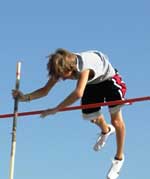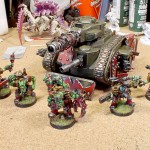Setting The Bar (or, I’m Not A Professional and This Isn’t a Fine Arts Class.)
 When someone decides to do something creatively/artistically, it’s usually based on something they’ve seen and want to emulate or duplicate. In this case maybe a friend has some metal laying around and painted a few, or the local bookstore had a copy of White Dwarf and you stumbled on it and marveled at the little works of art inside. It could be that you’re sick and tired of those grey plastic and silver pewter figures looking so boring on the tabletop. Whatever your motivation, it’s based on something you saw that you wanted to do yourself. This assumes you want to do more than slap tournament legal three colors down and call it a day. You probably wouldn’t be reading this if that suits you.
When someone decides to do something creatively/artistically, it’s usually based on something they’ve seen and want to emulate or duplicate. In this case maybe a friend has some metal laying around and painted a few, or the local bookstore had a copy of White Dwarf and you stumbled on it and marveled at the little works of art inside. It could be that you’re sick and tired of those grey plastic and silver pewter figures looking so boring on the tabletop. Whatever your motivation, it’s based on something you saw that you wanted to do yourself. This assumes you want to do more than slap tournament legal three colors down and call it a day. You probably wouldn’t be reading this if that suits you.

When you start painting there’s a certain level of ability that you want to achieve, a goal to strive for. “I want to be the best out of everyone I know”, “I want to win a contest” or “I want something that would be printed in White Dwarf.” CMON has nice way of quantifying this with their rating system. Although it has it’s flaws, as any system does, it’s a great starting point. This has become my yardstick by which I measure my progress and abilities. My goal at the beginning was to achieve and average score of 7. Most of the figures I saw in that range were very good but didn’t remind me of the Dutch Masters so it seemed achievable to me.
A few words of warning before we get to the technical stuff. I won’t be able to teach or tell you how to paint like the pros, I am not a pro. I can show you how I paint and only up to the level that I am currently at. As I learn more and get better I will most likely add to the Advanced Techniques chapters with this new knowledge. Armed with this information, most of the articles will be about miniature modeling and painting in general and not a fine arts class. I will show you how I go from darker red to a lighter orange to highlight a red but I won’t tell you why I’m using a red. Things like color theory, composition and art/design centric concepts will not be covered at length here.
The other thing I’m not good at (yet) is sculpting with greenstuff so you’ll need to look elsewhere for information on that, sorry.
Here’s what I plan to cover in this series of articles about miniature modeling and painting…
Intro: My experience/background and motivation. The focus of this series of articles. (you’re reading it right now)
Work Area and Tools and Supplies: Setting up your workspace and a comprehensive look at the tools and supplies common to miniatures and miniature painting.
Assembling: How to assemble both plastic and metal miniatures.
Painting: Basic techniques in painting with acrylics on miniatures. Covers primers, additives, applying paint and sealing/protecting.
Finishing: Basing your models
Advances Techniques (Beyond the basics): This will be a continuing section covering topics on blending, painting eyes, painting metals, etc. This is the more detailed stuff and assuming each article will cover a very narrow topic or technique.
Tips, tricks and Hints: A collection of one off tips, tricks, thoughts and ideas that really have no were else to go.
Please check back for the next installment: HOW TO MAKE PRETTY MODELS: Getting Started.
Randy Tenvoorde is a St. Cloud, MN native who designs/develops websites for a living. He’s been modeling and gaming nearly his entire life, preferring Warhammer 40K and Dungeons and Dragons as his geek games of choice (with a bit of Lunch Money thrown in for good measure).